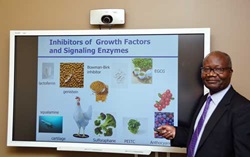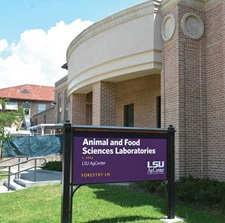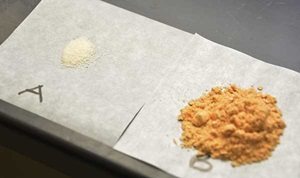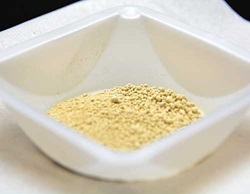Scientific Discovery Born in the Bayou
INSIDE ACADEMIA

Étouffée, gumbo, jambalaya, crawfish, po’ boys, zydeco, jazz, and Mardi Gras: The unique cuisine, customs, and music in the Bayou make the region a standout, but so do the dietary and health issues of its residents: According to the United Health Foundation, the state of Louisiana is ranked 49th for overall health and is among the five states (Mississippi, Louisiana, Arkansas, Alabama, and Oklahoma) with the highest incidence of certain chronic diseases. The rankings are a stark indicator that along the southern stretch of the Mississippi River, a disproportionate amount of people are suffering and dying from diseases that are largely preventable. Despite the dire circumstances of the health of Louisiana’s residents, there is a beacon of hope—the cutting-edge research taking place in the Bayou. Researchers at Louisiana State University (LSU) are investigating ways to use regional resources to formulate solutions to westernized dietary and nutrition challenges that also facilitate discoveries in global medicine and health.
 Antiangiogenic Foods
Antiangiogenic Foods
The chronic diseases that are weighing down the residents of Louisiana are the same plaguing the rest of the United States: cancer, cardiovascular disease, obesity, and type 2 diabetes. The cause of these diseases is a complex mix of genetic, environmental, and lifestyle factors with chronic inflammation playing a starring role. Another contributing factor to chronic disease is a process that is less obvious and rarely discussed: pathological angiogenesis. Angiogenesis is a normal biological process in humans; it is the formation and differentiation of blood vessels in the body. Because blood vessels are necessary to supply oxygen and other essential compounds to cells, angiogenesis is essential for physical development. Normally, the amount of blood vessels in the body remains static from birth through adulthood except during reproduction and tissue repair. “There are two types of angiogenesis: physiological angiogenesis and pathological angiogenesis,” says Jack Losso, a professor in LSU’s School of Nutrition and Food Sciences. “Physiological angiogenesis is very good because you need wound repair so the body can repair itself. Pathological angiogenesis is very damaging and is associated with more than 70 degenerative diseases, including cancer, obesity, psoriasis, Alzheimer’s disease, cardiovascular disease, diabetes, and many others.” Pathological angiogenesis can be either insufficient, in which the body does not generate enough blood vessels for tissues to heal, or excessive, in which new blood vessels grow to feed diseased tissue. “Insufficient angiogenesis occurs when, for instance, a wound does not heal. A diabetic wound is a classic example of insufficient angiogenesis. Excessive angiogenesis can be well characterized by cancer proliferation or even macular degeneration, in which too many blood vessels in the eyes prevent vision,” Losso says. “In an individual with diabetes, you may have the two types of angiogenesis coexisting—insufficient and excessive angiogenesis.”
 Losso has been investigating foods and bioactive compounds that counteract abnormal angiogenesis for about 20 years, but he wasn’t initially aware of the significance of his work. “I was doing angiogenesis research well before I knew about it,” Losso says. “I was doing a lot of work with soybeans, … trying to inhibit enzymes that are associated with the progression of diseases.” It turned out that most of those enzymes are associated with angiogenesis. The foods that were the focus of Losso’s research—antiangiogenic foods— contain compounds that control angiogenesis growth factors and inhibitors. “Angiogenesis is stimulated by many factors: growth factors, hypoxia, hormones, enzymes, proteins, minerals, oxidative stress, and oncogenes. We’re investigating foods that can inhibit some of these factors,” Losso says. “Some of them inhibit growth factors, some of them inhibit hypoxia, some will take care of hormones, some will address enzymes, and others will address oxidative stress or the minerals that are associated with angiogenesis. So you have foods that are rich in phenolic compounds, vitamins, saponins, carotenoids, carbohydrates, lipids, [and] proteins—these foods can be very good at inhibiting angiogenesis.” While there are pharmaceuticals that have been developed to inhibit angiogenesis, antiangiogenic foods, such as berries, tart cherries, fenugreek, green tea, kale, lima beans, oysters, and soybeans/tofu, are more effective and safer. “When you use an antiangiogenic drug, the drug just shuts down the angiogenic factor completely and irreversibly, which means that some of the physiological processes that are needed by the body will not take place because the enzyme has been completely inactivated,” Losso explains. “But when you eat antiangiogenic food, very often you don’t inactivate the enzyme irreversibly. You just reduce it to a physiological level at which it is needed for normal processes.”
Losso has been investigating foods and bioactive compounds that counteract abnormal angiogenesis for about 20 years, but he wasn’t initially aware of the significance of his work. “I was doing angiogenesis research well before I knew about it,” Losso says. “I was doing a lot of work with soybeans, … trying to inhibit enzymes that are associated with the progression of diseases.” It turned out that most of those enzymes are associated with angiogenesis. The foods that were the focus of Losso’s research—antiangiogenic foods— contain compounds that control angiogenesis growth factors and inhibitors. “Angiogenesis is stimulated by many factors: growth factors, hypoxia, hormones, enzymes, proteins, minerals, oxidative stress, and oncogenes. We’re investigating foods that can inhibit some of these factors,” Losso says. “Some of them inhibit growth factors, some of them inhibit hypoxia, some will take care of hormones, some will address enzymes, and others will address oxidative stress or the minerals that are associated with angiogenesis. So you have foods that are rich in phenolic compounds, vitamins, saponins, carotenoids, carbohydrates, lipids, [and] proteins—these foods can be very good at inhibiting angiogenesis.” While there are pharmaceuticals that have been developed to inhibit angiogenesis, antiangiogenic foods, such as berries, tart cherries, fenugreek, green tea, kale, lima beans, oysters, and soybeans/tofu, are more effective and safer. “When you use an antiangiogenic drug, the drug just shuts down the angiogenic factor completely and irreversibly, which means that some of the physiological processes that are needed by the body will not take place because the enzyme has been completely inactivated,” Losso explains. “But when you eat antiangiogenic food, very often you don’t inactivate the enzyme irreversibly. You just reduce it to a physiological level at which it is needed for normal processes.”
 Besides finding foods that block angiogenesis, Losso and his laboratory team have been investigating foods and developing food products that combat diabetes, obesity, celiac disease, ulcerative colitis, Crohn’s disease, multiple sclerosis, fibromyalgia, cancer, and insomnia. “Right now, I have ongoing research on pancreatic cancer in which we are using a compound from walnuts called juglone. We have shown that juglone inhibits angiogenesis in pancreatic cancer. I also have ongoing research on ulcerative colitis and tart cherries. We have shown that inflammation is reduced and the disease improves when rats with pancreatic cancer receive the equivalent of two servings of tart cherries,” Losso reveals. “We’ve developed a bread containing fenugreek for people with diabetes; it reduces insulin resistance. … We are investigating how we can use food such as soybeans to help people who have multiple sclerosis. I am also involved in a clinical study involving inflammation and type 2 diabetes: We are feeding red raspberries to people with type 2 diabetes for two weeks and studying the effect of raspberries on inflammation markers.” In addition, Losso just completed a study demonstrating that a compound from cocoa inhibits the enzyme that is associated with celiac disease. And many antiangiogenic foods—asparagus, berries, black beans, raw cocoa, garlic, green tea, sweet potato leaves, tart cherries, and turmeric—contain bioactive compounds that also combat inflammation.
Besides finding foods that block angiogenesis, Losso and his laboratory team have been investigating foods and developing food products that combat diabetes, obesity, celiac disease, ulcerative colitis, Crohn’s disease, multiple sclerosis, fibromyalgia, cancer, and insomnia. “Right now, I have ongoing research on pancreatic cancer in which we are using a compound from walnuts called juglone. We have shown that juglone inhibits angiogenesis in pancreatic cancer. I also have ongoing research on ulcerative colitis and tart cherries. We have shown that inflammation is reduced and the disease improves when rats with pancreatic cancer receive the equivalent of two servings of tart cherries,” Losso reveals. “We’ve developed a bread containing fenugreek for people with diabetes; it reduces insulin resistance. … We are investigating how we can use food such as soybeans to help people who have multiple sclerosis. I am also involved in a clinical study involving inflammation and type 2 diabetes: We are feeding red raspberries to people with type 2 diabetes for two weeks and studying the effect of raspberries on inflammation markers.” In addition, Losso just completed a study demonstrating that a compound from cocoa inhibits the enzyme that is associated with celiac disease. And many antiangiogenic foods—asparagus, berries, black beans, raw cocoa, garlic, green tea, sweet potato leaves, tart cherries, and turmeric—contain bioactive compounds that also combat inflammation.
 Food in a DASH
Food in a DASH
Pioneering research on dietary approaches to prevent chronic disease is happening in other LSU laboratories as well. LSU’s Pennington Biomedical Research Center was significantly involved in developing the diet that has been named the best diet overall by U.S. News and World Report for seven years in a row: Dietary Approaches to Stop Hypertension (DASH). “The Pennington Center’s mission is to discover the triggers of chronic diseases through innovative research that improves human health across the lifespan,” says Catherine Champagne, professor and director of nutritional epidemiology and dietary assessment at Pennington. “There’s a lot of disease conditions for which diet is either the cause or a potential mechanism to alleviate the disease.” Champagne was instrumental in designing the DASH diet. “We at Pennington met as a team, and we proposed a diet that addressed blood pressure. The NIH looked at all the applications that were submitted that were targeting blood pressure, and they chose four centers,” Champagne explains. The other three centers were Brigham and Women’s Hospital in Boston, Mass.; Duke University Hypertension Center in Durham, N.C.; and Johns Hopkins Medical Institutions in Baltimore, Md. Dietitians at Pennington and the other three medical research centers were asked by the National Institutes of Health to submit diet plans targeting hypertension for analysis. Champagne’s diet plan was chosen as the best to meet all nutritional parameters. “I actually designed all the diets for the four centers across the United States,” Champagne muses. “Because I had done a lot of work with food composition, I was probably a little more food savvy, so to speak.” Champagne has been working with the agriculture, nutrition, and food science faculty on various projects since she began working for LSU more than 28 years ago. In that time, she has studied a lot of diet and nutrition plans and has made a few observations: “A lot of chronic disease conditions are related to diet: diabetes, cardiovascular disease, [and] certain cancers” she asserts. “Even though the DASH diet was developed for blood pressure, we have found positive changes in blood lipids and a positive impact on cancer. It is also a good diet for diabetes.” However, for many individuals, DASH and other diets seem to have little or no effect on obesity. “I like to think that if you eat well and you are active, then you will be a normal healthy weight,” she says, “but I know people who say that they have restricted their diet yet they cannot lose weight. … So I really feel like obesity is multifactorial.” Some of those factors may be found in the mysteries of gut microbiota.
Food With a Gut Impact
Some research studies indicate that infants born via cesarean section and formula-fed babies have increased risks for obesity as well as other chronic conditions (e.g., allergies, asthma, cardiovascular disease, immune deficiencies, leukemia, and inflammatory bowel disease). Other research suggests that intestinal dysbiosis—an imbalance between good microbes and pathogenic microbes in the colon—contributes to obesity and chronic diseases. Regardless of which theory is accurate, most scientists believe that the gut microbiome helps determine human health, influencing the tendency to store fat or burn it and stimulating low-grade inflammation, which would have implications in the management of obesity and other chronic diseases. In addition, gut microbiota metabolize parts of food that humans could not digest without them, such as folate, vitamin B12, vitamin K, and certain types of fiber known as prebiotics. Pre-biotics are nondigestible carbohydrates that are fermented in the colon. This colonic fermentation yields gases, such as methane and carbon dioxide, and short-chain fatty acids. The short-chain fatty acids lower the pH of the colon, transform the gut into an inhospitable acidic environment for pathogenic bacteria, and regulate immune responses. Prebiotics and probiotics (beneficial gut microbes) are considered key to establishing a healthy gut microbiome.
 “We don’t know exactly what a healthy microbiome is. [There are] probably different versions of it, depending on culture and foods you eat,” says Michael Kennan, a professor at LSU’s School of Nutrition and Food Sciences. This is because the microbiome of each human is distinct and not subject to a one-size-fits-all solution. “No one knew or fully understood the microbiome of the gut. It is more complex than anyone realizes. Each individual has his [or] her own microbiota family,” says Subramaniam Sathivel, a professor of food engineering at LSU’s School of Nutrition and Food Sciences. Nonetheless, both Keenan and Sathivel believe that it is still possible to improve the profile of each gut microbiome. “How do you get the right kind of microbes to grow in the gut? You need fermentable fibers … and probiotics,” says Keenan. “There are all kinds of fermentable fibers, and resistant starch is one type. Resistant starch is anything that resists digestion by the amylase enzyme that digests starch. Whole grains will do that, and so will most corn and legumes.” The benefit of taking probiotics, however, is more difficult to realize: “Four years ago, my student and I found that most of the probiotics [taken orally] do not survive in the gut,” Sathivel says. To find a solution to this issue, Sathivel looked to his grandmother, who lived to be 100 years old without ever getting ill. “I always questioned how [my grandmother] lived that long eating just rice and yogurt,” Sathivel muses. Figuring that probiotics may have had something to do with his grandmother’s health and longevity yet knowing that few probiotics consumed orally survive the trek to the colon, Sathivel began to think that rice could be the answer to delivering more live microorganisms to the colon. Keenan agreed: “You’ve got to feed the prebiotics when you give the probiotics. … You’ve got to have the right bacteria to be able to ferment the prebiotic,” he says. Sathivel and Keenan collaborated on a project that meets that objective: a probiotic encapsulated in fermentable fiber. “For encapsulation, we are using certain coating materials to create two things: one is the core, and one is the shell or coating,” Sathivel reveals. “The core material could be a probiotic or any bioactive component that you want to preserve or deliver to certain places. For probiotics, we coat it with rice bran fiber or some other fermentable fiber. The probiotic is live inside. When the encapsulated probiotics reach the colon, the gut microbiota will [metabolize] the rice bran and the encapsulated probiotics are released.” The decision to use rice bran was an easy one. “We are in Louisiana, and there’s plenty of rice and rice processing around here,” Sathivel points out. “We will eventually try using other fermentable fibers, but because we are in Louisiana, … rice bran is easy to deliver, and it costs less than other fibers. Also, rice bran fiber is available in a lot of other countries.”
“We don’t know exactly what a healthy microbiome is. [There are] probably different versions of it, depending on culture and foods you eat,” says Michael Kennan, a professor at LSU’s School of Nutrition and Food Sciences. This is because the microbiome of each human is distinct and not subject to a one-size-fits-all solution. “No one knew or fully understood the microbiome of the gut. It is more complex than anyone realizes. Each individual has his [or] her own microbiota family,” says Subramaniam Sathivel, a professor of food engineering at LSU’s School of Nutrition and Food Sciences. Nonetheless, both Keenan and Sathivel believe that it is still possible to improve the profile of each gut microbiome. “How do you get the right kind of microbes to grow in the gut? You need fermentable fibers … and probiotics,” says Keenan. “There are all kinds of fermentable fibers, and resistant starch is one type. Resistant starch is anything that resists digestion by the amylase enzyme that digests starch. Whole grains will do that, and so will most corn and legumes.” The benefit of taking probiotics, however, is more difficult to realize: “Four years ago, my student and I found that most of the probiotics [taken orally] do not survive in the gut,” Sathivel says. To find a solution to this issue, Sathivel looked to his grandmother, who lived to be 100 years old without ever getting ill. “I always questioned how [my grandmother] lived that long eating just rice and yogurt,” Sathivel muses. Figuring that probiotics may have had something to do with his grandmother’s health and longevity yet knowing that few probiotics consumed orally survive the trek to the colon, Sathivel began to think that rice could be the answer to delivering more live microorganisms to the colon. Keenan agreed: “You’ve got to feed the prebiotics when you give the probiotics. … You’ve got to have the right bacteria to be able to ferment the prebiotic,” he says. Sathivel and Keenan collaborated on a project that meets that objective: a probiotic encapsulated in fermentable fiber. “For encapsulation, we are using certain coating materials to create two things: one is the core, and one is the shell or coating,” Sathivel reveals. “The core material could be a probiotic or any bioactive component that you want to preserve or deliver to certain places. For probiotics, we coat it with rice bran fiber or some other fermentable fiber. The probiotic is live inside. When the encapsulated probiotics reach the colon, the gut microbiota will [metabolize] the rice bran and the encapsulated probiotics are released.” The decision to use rice bran was an easy one. “We are in Louisiana, and there’s plenty of rice and rice processing around here,” Sathivel points out. “We will eventually try using other fermentable fibers, but because we are in Louisiana, … rice bran is easy to deliver, and it costs less than other fibers. Also, rice bran fiber is available in a lot of other countries.”
 The encapsulated probiotic is in a powder format and is still in the testing phase. Preliminary tests designed by Keenan and Sathivel, in which they used a laxative to clean out the colon of animal subjects and then fed to them the encapsulated probiotic, have provided really good results. Sathivel believes that the product will prove to be effective in future testing because “from observing my grandmother, I know that this works.”
The encapsulated probiotic is in a powder format and is still in the testing phase. Preliminary tests designed by Keenan and Sathivel, in which they used a laxative to clean out the colon of animal subjects and then fed to them the encapsulated probiotic, have provided really good results. Sathivel believes that the product will prove to be effective in future testing because “from observing my grandmother, I know that this works.”
 Sathivel, Keenan, Champagne, and Losso are all using food to address chronic disease. Their discoveries and solutions could help improve the diet, health, and nutrition of the residents of all 50 states, but there is a limiting factor. “Funding to do human studies is not easy to obtain,” Losso observes. Sathivel agrees: “We’ve been testing only in animal models because there is an elevated cost to test humans, and we don’t have the money for that.” Even so, the amazing ability of food to combat chronic disease will eventually have to be acknowledged across the span of stakeholders in medicine, food, and public policy, according to Sathivel. “I think that in the future, food will be everyone’s medicine,” he predicts. “The future of food should be a food scientist or technologist, a medical doctor, and an engineer working together to design foods for health solutions,” Sathivel asserts. “We need more money for this kind of research.” Until that funding appears, the researchers at LSU will continue to find ways to elevate food and nutrition to the next level.
Sathivel, Keenan, Champagne, and Losso are all using food to address chronic disease. Their discoveries and solutions could help improve the diet, health, and nutrition of the residents of all 50 states, but there is a limiting factor. “Funding to do human studies is not easy to obtain,” Losso observes. Sathivel agrees: “We’ve been testing only in animal models because there is an elevated cost to test humans, and we don’t have the money for that.” Even so, the amazing ability of food to combat chronic disease will eventually have to be acknowledged across the span of stakeholders in medicine, food, and public policy, according to Sathivel. “I think that in the future, food will be everyone’s medicine,” he predicts. “The future of food should be a food scientist or technologist, a medical doctor, and an engineer working together to design foods for health solutions,” Sathivel asserts. “We need more money for this kind of research.” Until that funding appears, the researchers at LSU will continue to find ways to elevate food and nutrition to the next level.
Toni Tarver is senior writer/editor, Food Technology magazine ([email protected]).

